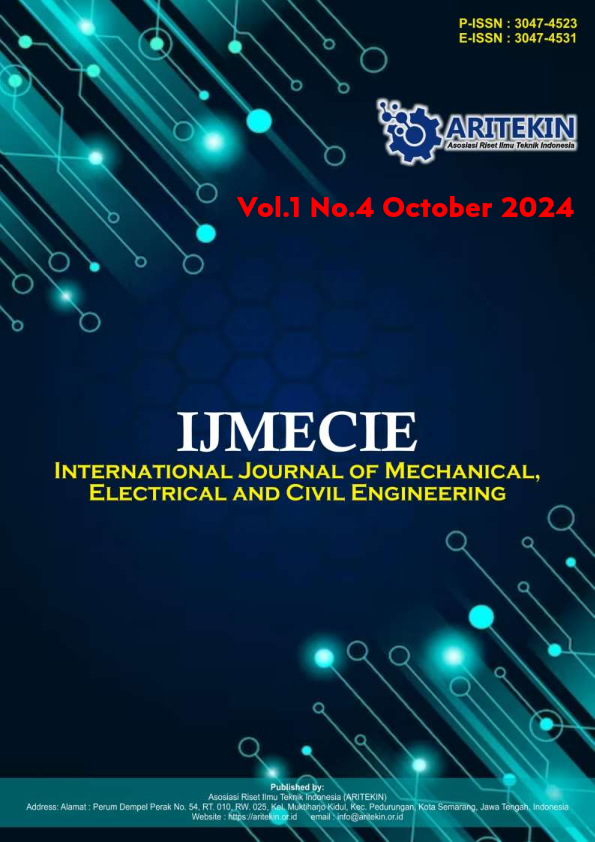Performance Evaluation and Analysis Of Unsignaled Interceptions
Case Study: Raya Blega Street-Rajawali Street Bangkalan District
DOI:
https://doi.org/10.61132/ijmecie.v1i4.39Keywords:
Raya Blega Street Intersection, Unsignalized Intersection, PKJI 2023, Degree of Saturation, DelayAbstract
The Raya Blega Street intersection is one of the intersections with a relatively high vehicle volume in Bangkalan Regency. There is no APILL (Traffic Signaling Device) available at this intersection, so it has an impact on traffic flow at the intersection. The existence of the market causes many side obstacles which reduce the optimal performance of the intersection. This condition causes the intersection to experience traffic delays, especially during peak hours such as when leaving work or when leaving. In this research, researchers want to identify the problem of congestion at the Raya Blega street-Rajawali street intersection by calculating and analyzing the performance of the Raya Blega street-Rajawali street intersection using the PKJI 2023 method so that it can be used as a benchmark for assessing the performance of unsignalized intersections and assisting related parties in handle problems at the intersection and it is hoped that they can handle the problems that occur at the intersection so that it can create security and safety for passing users.In this study, the highest value was obtained for existing conditions on Monday, April 29 2024, at morning peak hours (07.00-08.00) at approach point A (east Raya Blega street) with an intersection capacity value of 2297,96 smp/hour and the value obtained The degree of saturation is 0,36 and the delay value is 8.44 sec/smp so it is included in Level of Service B. So the status of the Raya Blega street-Rajawali street Bangkalan Regency intersection is still suitable to be maintained.
References
Adisatria, W., & Djakfar, L. (2015). Manajemen lalu lintas pada kawasan pasar Tanjung. Jurnal Rekayasa Sipil, 9(1), 9.
Ali, M. I., & Abidin, M. R. (2019). Pengaruh kepadatan penduduk terhadap intensitas kemacetan lalu lintas di Kecamatan Rappocini Makassar. Prosiding Seminar Nasional Lembaga Penelitian Universitas Negeri Makassar, 68–73.
Anggraini, R. A., Sinaga, Y. E., Lestari, F., Pramita, G., & Kastamto, K. (2022). Evaluasi simpang tak bersinyal dan perencanaan Apill. JICE (Journal of Infrastructural in Civil Engineering), 3(2), 32. https://doi.org/10.33365/jice.v3i02.2152
Bappenas, Jawa Timur. (2022, Desember 13). Berita Tm Bappenas RI tinjau lokasi lintas selatan Madura di Kabupaten Sampang. Dinas Kominfo Jawa Timur. Retrieved from https://kominfo.jatimprov.go.id/berita/tim-bappenas-ri-tinjau-lokasi-jalan-lintas-selatan-madura-di-kabupaten-sampang
Direktorat Jenderal Bina Marga. (1997). Manual kapasitas jalan Indonesia, 3860CHAP1R-1.WPD 8 Oktober 1996/HA/BH.
Direktorat Jenderal Bina Marga. (2023). Pedoman kapasitas jalan Indonesia. Kementerian PUPR.
Hajia, M. C. (2022). Pengaruh pasar tradisional terhadap arus lalu lintas. Jurnal Simki Economic, 5(2), 165–171. https://doi.org/10.29407/jse.v5i2.152
Harisda, R. (2016). Analisis kinerja persimpangan tak berinisiyal (Studi Kasus: Simpang Sisingamaraja dengan Jalan Purnama dan Jalan Sentosa-Meulaboh) (Doctoral dissertation, Universitas Teuku Umar Meulaboh).
Hasibuan, D. Y. F. C., & Muttaqin, M. Z. (2021). Analisis kinerja simpang tak bersinyal persimpangan pasar Sibuhuan, Kabupaten Padang Lawas, Sumatera Utara. Jurnal Saintis, 21(1), 53–60. https://doi.org/10.25299/saintis.2021.vol21(01).6507
Herdiyana, I. (2024, April 09). Pengguna jalan tak berakhlak bikin macet jalan raya Blega dan pasar Tanah Merah. Radar Madura. Retrieved from https://radarmadura.jawapos.com/bangkalan/744529540/pengguna-jalan-tak-berakhlak-bikin-macet-jalan-raya-blega-dan-pasar-tanah-merah
Lalenoh, R. H., Sendow, T. K., & Jansen, F. (2015). Analisa kapasitas ruas jalan Sam Ratulangi dengan metode MKJI 1997 dan PKJI 2014. Jurnal Sipil Statik, 3(11), 737–746.
Lubis, M. (2022). Penerapan manajemen lalu lintas pada pembangunan pasar Sibolga Nauli Kota Sibolga. Seminar Nasional Teknik (SEMNASTEK) UISU, 5(1), 181–188.
Maghfiroh, L. (2023). Manajemen dan rekayasa lalu lintas pada jalan simpang tiga Mengkreng Kediri (Undergraduate thesis, UPN “Veteran” Surabaya).
Mu, A. (2019). Pengertian pasar menurut kegiatannya. Pengertian Pasar Menurut Kegiatannya, 53(9), 1689–1699.
Mustikarani, W., & Suherdiyanto. (2016). Analisis faktor-faktor penyebab kemacetan lalu lintas di sepanjang Jalan H Rais A Rahman (Sui Jawi) Kota Pontianak. Jurnal Edukasi, 14(1), 143–155.
Nabiliansyah, R. (2022). Manajemen lalu lintas di kawasan pasar Kembang Kota Surabaya (Undergraduate thesis, UPN “Veteran” Surabaya).
Ohotan, A., Kumaat, M. M., & Pandey, S. V. (2023). Analisis kinerja simpang tak bersinyal menggunakan metode PKJI 2014. 21(84).
Prayoga, M. D., Ircham, & Anggorowati, V. D. A. (2020). Analisis daya tampung jalan dan manajemen lalu lintas. Equilib, 01(01), 41–52.
Rahadiyan, A. P. (2018). Analisis antrian dan tundaan kendaraan pada simpang tiga bersinyal Jl. Raya Pekayon. Retrieved Juli 2021, from http://repository.unj.ac.id/19/
Sudini, L. P., Amerta, I. M. S., & Pratiwi, N. M. W. (2021). Manajemen lalu lintas di jalan Akasia guna menghindari kemacetan. Jurnal Abdi Daya, 1(1), 28–36.
Tamin, O. Z. (n.d.). Hubungan volume. Jurnal Teknik Sipil, Jurusan Teknik Sipil ITB, 5, 1–11.
Waris, M. (2022). Analisis kinerja simpang tak bersinyal metode pedoman kapasitas jalan Indonesia 2014. J-HEST Journal of Health Education Economics Science and Technology, 1(1), 46–54. https://doi.org/10.36339/jhest.v1i1.20
Downloads
Published
How to Cite
Issue
Section
License
Copyright (c) 2024 International Journal of Mechanical, Electrical and Civil Engineering

This work is licensed under a Creative Commons Attribution-ShareAlike 4.0 International License.





